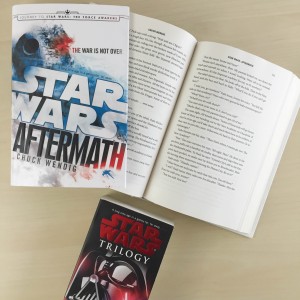Review: Star Wars: Aftermath by Chuck Wendig
Synopsis for Star Wars: Aftermath
As the Empire reels from its critical defeats at the Battle of Endor, the Rebel Alliance—now a fledgling New Republic—presses its advantage by hunting down the enemy’s scattered forces before they can regroup and retaliate. But above the remote planet Akiva, an ominous show of the enemy’s strength is unfolding. Out on a lone reconnaissance mission, pilot Wedge Antilles watches Imperial Star Destroyers gather like birds of prey circling for a kill, but he’s taken captive before he can report back to the New Republic leaders.
Meanwhile, on the planet’s surface, former rebel fighter Norra Wexley has returned to her native world—war weary, ready to reunite with her estranged son, and eager to build a new life in some distant place. But when Norra intercepts Wedge Antilles’s urgent distress call, she realizes her time as a freedom fighter is not yet over. What she doesn’t know is just how close the enemy is—or how decisive and dangerous her new mission will be.
Determined to preserve the Empire’s power, the surviving Imperial elite are converging on Akiva for a top-secret emergency summit—to consolidate their forces and rally for a counterstrike. But they haven’t reckoned on Norra and her newfound allies—her technical-genius son, a Zabrak bounty hunter, and a reprobate Imperial defector—who are prepared to do whatever they must to end the Empire’s oppressive reign once and for all.

With the recent release of Star Wars: The Force Awakens in theaters crushing box office records left and right and the torrent of tie-in merchandise flooding store shelves over the holidays, there’s arguably never been a better time to be a Star Wars fan intent on showing off your fandom. That is, unless you’re a fan of Star Wars books. Star Wars: Aftermath is christened a “Journey to Star Wars: The Force Awakens”, part of the larger Disney push to rebuild the Star Wars canon (after they decided that the greater Expanded Universe of novels and comics was irrelevant), but it doesn’t really feel like a part of the continuity or transition from Episode 6 to Episode 7; instead it is simply a stand-alone novel, an action thriller set on an Outer Rim planet we’ve never heard of before.
The planet itself is fairly well-realized in the book, though it would be more accurate to state that the capital city of said planet is fairly well-realized. There is a sense of age and mystery about the city that the author does well in building without going on long expository tangents, a skill that is often hard to find in books of a tie-in nature. However, there is an overwhelming feeling of smallness in Star Wars: Aftermath – despite the big Imperial meeting, the huge ramifications of the characters’ actions, and the usual epic scale of anything Star Wars. Most of the action takes place in the relatively small confines of a backwater capital on the Outer Rim; similar to the settings that gave birth to Anakin, Luke, and Rey. However, those legends swiftly found themselves taken away from their humble beginnings, while Aftermath never leaves it.
Not everyone will agree, but I found the use of the present tense throughout the book to be a bold and unique choice that paid off. Present tense places the reader right in the action, exactly what you want in an action thriller, and Mr. Wendig managed to use present tense as skillfully as anyone could ask. What it doesn’t lend itself well to, however, is character development, which was a bit below par for nearly every character. With only one or two notable exceptions, the characters came across as incredibly flat, most particularly Norra Wexley, the lead protagonist among the ragtag crew that forms across the length of the book.
Action novels live and die primarily on the author’s ability to pace the narrative well, which Mr. Wendig undoubtedly did – with the exception of a string of ‘Interlude’ chapters, scattered throughout the book and having no apparent connection to the main narrative, or even to each other most of the time. By the end of the book I was giving these Interludes the barest amount of attention possible, skimming them to make sure I didn’t miss any connection to the main narrative before moving on. Perhaps they were intended to help deliver that sense of scale that Aftermath is missing and that a proper Star Wars product should always have, but if they were they fail at it.
Aftermath is the first of a planned trilogy (because of course it is) and, honestly, gets the effort off to a bit of a rocky start. Perhaps those Interlude chapters will find a more clearly defined meaning as the trilogy wears on; perhaps the characters who were flat but important (such as Norra Wexley) will find themselves tested to a greater extent in future installments; perhaps I’ll even read the rest of them. Right now, however, I find myself severely underwhelmed by the first piece of the New Universe of Star Wars, at a time when I should be gobbling up every bit of Star Wars fiction I can get my hands on. I haven’t lost all hope, of course – I’m looking into John Jackson Miller’s A New Dawn novel to see if the ‘Disneyfied’ expanded universe is worth the time and effort – but this New Universe and I? We’re off to a bit of a rocky start.
Latest posts by David Andrews (see all)
- March’s Culture Carton Reveal - March 28, 2017
- Review: The Collapsing Empire by John Scalzi - March 16, 2017
- February’s Culture Carton Reveal & Review - February 20, 2017